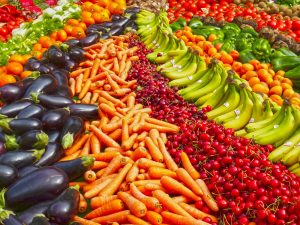Fiber can help you lose weight and protect against certain cancers, heart disease, and type 2 diabetes. Find out how!

Dietary fiber used to be known as roughage. It comprises the edible parts of plants that are not broken down and absorbed in the human gastrointestinal tract.
Fiber comprises structural plant polysaccharides such as cellulose.
The human small intestine has no enzymes to break down these polysaccharides (and thus they cannot be digested).
Although cellulose may be the most common type of fiber, there are many other types of fiber, including gums, hemicellulose, ß-glucans, and pectin.
Dietary fiber comprises nondigestible carbohydrate and lignin that are intrinsic and intact in plants.
Functional fiber comprises isolated, nondigestible carbohydrate that have beneficial physiological effects in humans.
Total fiber is the sum of dietary fiber and functional fiber, and it is the intake of total fiber that matters most.
Dietary fiber is also often divided into soluble and insoluble fiber. Soluble fiber dissolves well in water, whereas insoluble fiber does not.
Both types of fiber are present in plant foods. Some plants contain more soluble fiber, and others have more insoluble fiber.
THE FUNCTIONS OF INSOLUBLE FIBER:
- Has its effects mainly in the colon, where it adds bulk and helps retain water, which results in a softer and larger stool.
- Decreases the transit time of fecal matter through the intestines. So, a diet high in insoluble fiber is most often used in treatment of constipation resulting from poor dietary habits and promotes bowel regularity.
THE FUNCTIONS OF SOLUBLE FIBER:
- Lowers blood cholesterol concentrations and normalizes blood glucose.
- In addition, most soluble fiber is highly fermentable, and fermentable fibers help maintain healthy populations of friendly bacteria.
- Besides producing necessary short-chain fatty acids, these bacteria play an important role in the immune system by preventing pathogenic (disease-causing) bacteria from surviving in the intestinal tract.
- Fiber also has several effects on nutrient digestion and absorption. It reduces the rate of gastric emptying and can influence the absorption of various micronutrients. Fiber increases food bulk, which increases satiety, and it can reduce energy intake by 96-143 kcal/day, meaning you’re likely to feel fuller, eat less overall calories and may help you maintain a healthy weight.
HEALTH BENEFITS OF EATING MORE FIBRE
- High fiber intake, both soluble and insoluble fibre from cereal and vegetable sources are associated with decreased risk of cardiovascular disease (Slyper 2013).
- Fruit fiber intake is associated with a reduced risk of cardiovascular disease.
- Fruits, vegetables, and plant fiber have long been thought to protect against cancer. Indeed, high intake of fruits and vegetables is associated with reduced incidence of some cancers; however, this may be related not only to fiber intake but also to intake of folic acid (Willett 2000) and other phytonutrients (carotenoids, which are found in carrots, broccoli, yellow and leafy green vegetables, and other vegetables, and polyphenols, which are found in various berries, fruits, tea, beer, and wine)
- Fruit intake can reduce the risk of cancer of the upper gastrointestinal tract
- Total fruit and vegetable and total fiber intakes can reduce the risk of colorectal cancer
- Total fiber intake can reduce the risk of liver cancer
- Fruit intake can reduce the risk of lung cancer among smokers
- A borderline inverse association of fiber intake has been associated with reduced breast cancer risk
- One potential mechanism for reduced cancer risk is the reduced transit time of food (the time that food spends in the gut) because of fiber intake, which could reduce the uptake of carcinogenic substances. Another mechanism is that the fiber absorbs some of these carcinogenic substances. In addition, a change in fiber intake may result from altered nutritional habits that reduce carcinogenic substances (i.e., increased fiber intake is often accompanied by decreased fat intake).
- Higher fiber intake has also been associated with better weight maintenance.
- Increasing dietary fiber intake is often recommended because of its apparent protective effects against cancers, cardiovascular diseases, and type 2 diabetes.
RECOMMENDED INTAKE OF FIBER
For most people, the recommended intake would be 20 to 35 g/day, but the typical fiber intake in Western countries is only 14 to 15 g/day.
GOOD SOURCES OF FIBER
| TYPE OF FIBER | FOOD SOURCES |
| SOLUBLE FIBER |
|
| INSOLUBLE FIBER |
|
Peter Azzopardi is an in-home personal trainer in Suffolk and Norfolk. He is currently studying a Post-Graduate Diploma in Performance Nutrition, which focuses on the latest research into nutrition for health, exercise and performance. In addition, Peter has been one of Upbeat’s Cardiac Rehabilitation Exercise Instructors for the past 14 years. For information on his services, please contact him directly: www.pmapersonaltraining.com/contact

